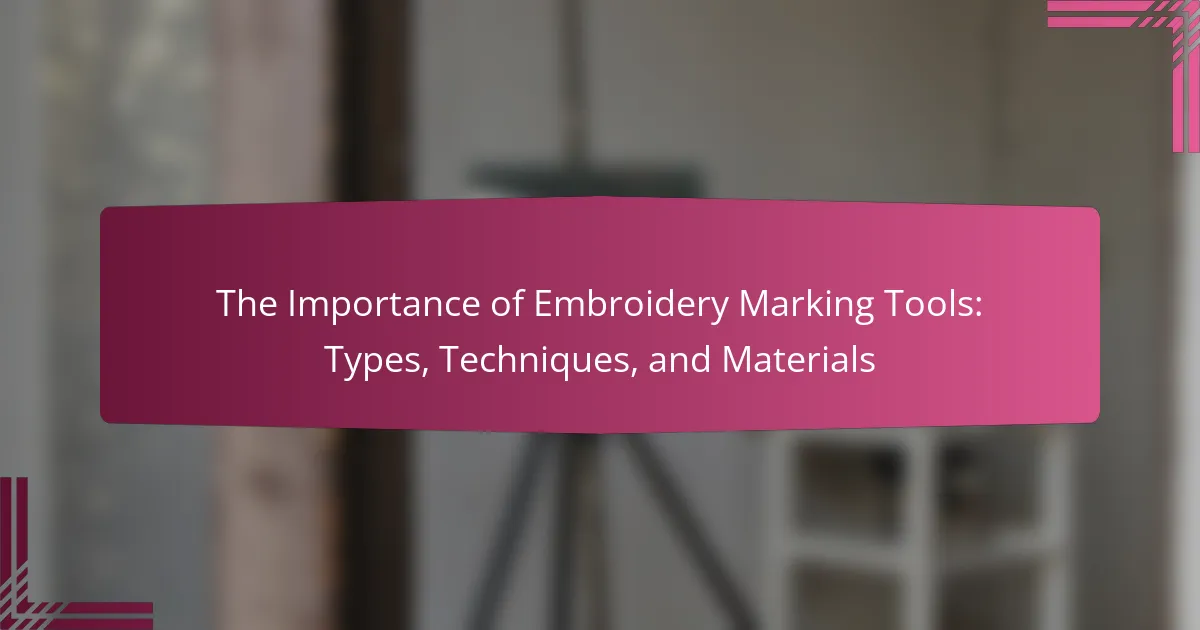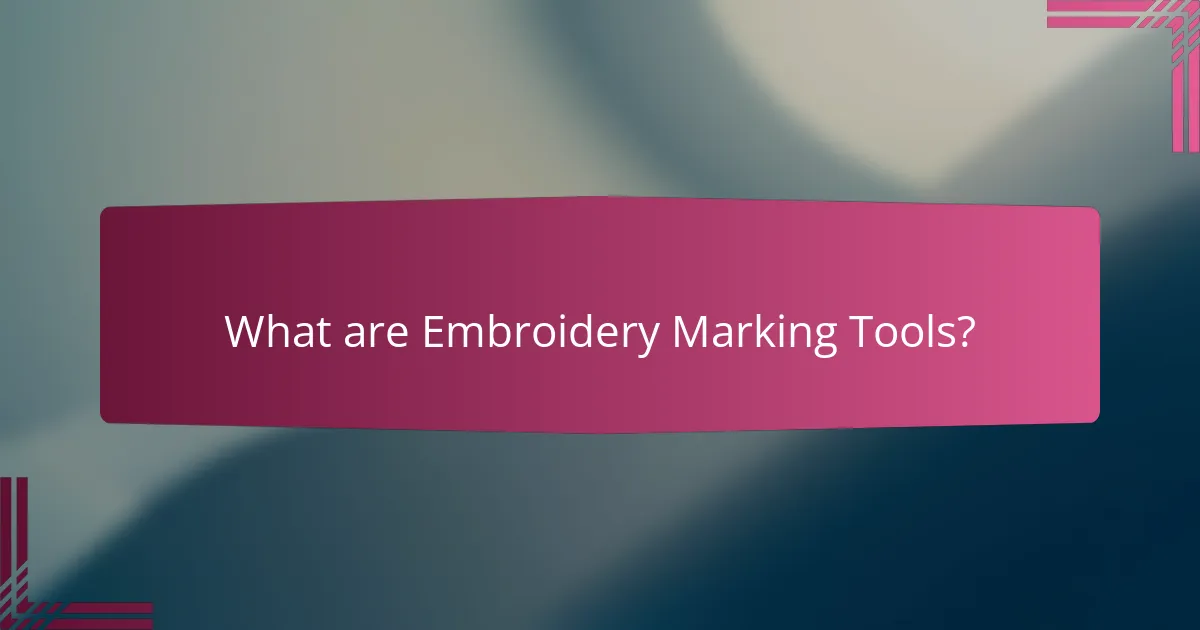
What are Embroidery Marking Tools?
Embroidery marking tools are instruments used to create temporary markings on fabric for embroidery projects. These tools help in accurately positioning designs and patterns before stitching. Common types include fabric pens, chalk pencils, and water-soluble markers. Each tool serves a specific purpose in marking fabric without causing permanent damage. For instance, water-soluble markers disappear with moisture, ensuring clean results. Fabric pens offer precise lines that can be easily removed. Accurate markings are essential for achieving professional-quality embroidery. These tools enhance precision and efficiency in the embroidery process.
How do Embroidery Marking Tools function in the crafting process?
Embroidery marking tools function by providing precise guidelines for stitching patterns onto fabric. They help crafters outline designs before actual embroidery begins. Common types include fabric pens, chalk markers, and water-soluble pens. These tools allow for temporary markings that can be easily removed or washed away. Accurate markings ensure that stitches are placed correctly, enhancing the overall quality of the finished piece. Using these tools reduces the risk of errors during the embroidery process. Additionally, they save time by eliminating the need for guesswork. Proper usage of marking tools leads to more professional-looking results in embroidery projects.
What are the key components of Embroidery Marking Tools?
The key components of embroidery marking tools include fabric markers, chalk pencils, and water-soluble pens. Fabric markers are designed for use on textiles and provide clear, bold lines. Chalk pencils allow for precise marking without leaving permanent traces. Water-soluble pens create temporary markings that wash away with water. These tools help ensure accuracy in embroidery projects. Each component serves a specific purpose in the marking process, enhancing the overall quality of the work.
How do different components impact the marking process?
Different components significantly impact the marking process in embroidery. Tools such as markers, pens, and chalk influence the visibility and accuracy of markings. The choice of fabric affects how well the marking medium adheres and shows up. Marking techniques, like tracing or freehand, determine the precision of the design. Additionally, the type of embroidery thread can affect how markings are perceived once the design is stitched. For instance, lighter fabrics may require darker inks for clear visibility. The marking medium’s drying time can also impact workflow efficiency. Inaccurate markings can lead to errors in stitching, making component selection crucial for successful embroidery.
Why are Embroidery Marking Tools essential for crafters?
Embroidery marking tools are essential for crafters because they ensure precision in design placement. These tools help crafters accurately transfer patterns onto fabric. Accurate markings lead to better alignment and symmetry in embroidery projects. Using marking tools minimizes errors during stitching. This results in a polished and professional finish. Various types of marking tools, such as chalk pencils and water-soluble pens, cater to different fabric types. Their effectiveness is supported by the fact that precise markings can significantly improve the overall quality of the finished product.
What advantages do these tools provide in embroidery projects?
Embroidery marking tools enhance precision and efficiency in embroidery projects. They help in accurately transferring designs onto fabric. This ensures consistent placement and alignment of patterns. Marking tools also facilitate easy adjustments during the embroidery process. They save time by reducing the need for trial and error. Additionally, these tools minimize fabric distortion. This results in cleaner and more professional finishes. Overall, they significantly improve the quality of the final embroidered product.
How do they enhance precision and creativity in embroidery?
Embroidery marking tools enhance precision and creativity by providing accurate guidance for stitching. These tools include fabric markers, rulers, and stencils. They allow for detailed designs to be transferred onto fabric. Precise markings ensure consistent stitch placement. This leads to cleaner, more professional-looking results. Additionally, creative designs can be easily visualized before stitching begins. Tools like stencils encourage unique patterns that can be replicated. Overall, these tools streamline the embroidery process and inspire artistic expression.
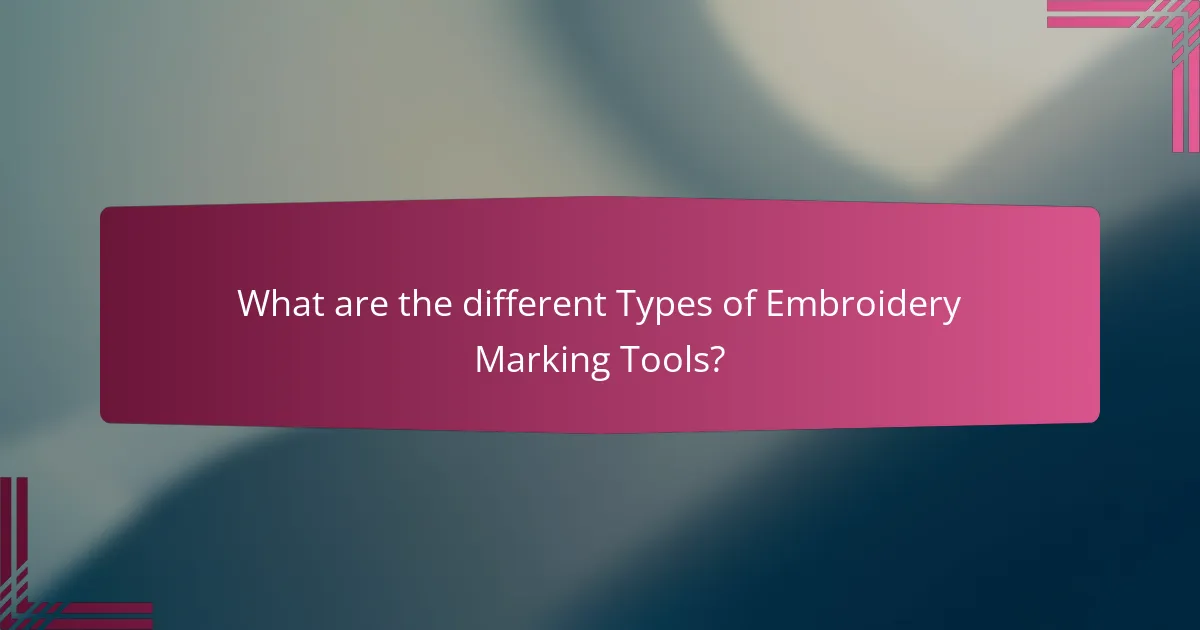
What are the different Types of Embroidery Marking Tools?
Embroidery marking tools include various types designed for different purposes. Common types are fabric markers, chalk pencils, and water-soluble pens. Fabric markers provide a permanent solution for marking designs on fabric. Chalk pencils offer a temporary option that can be brushed away after use. Water-soluble pens are ideal for precision marking, as they disappear with water. Each tool has unique attributes that cater to specific marking needs in embroidery projects.
What are the most commonly used types of Embroidery Marking Tools?
The most commonly used types of embroidery marking tools include fabric markers, chalk pencils, and water-soluble pens. Fabric markers are designed to create permanent or temporary marks on fabric. They come in various colors and tip sizes. Chalk pencils offer a fine line for precise marking and can be easily brushed off. Water-soluble pens provide marks that disappear with water, making them ideal for temporary designs. These tools are essential for accurate placement and alignment in embroidery projects. Their effectiveness is supported by their widespread use among both hobbyists and professionals in the textile industry.
How does each type serve a specific purpose in embroidery?
Each type of embroidery marking tool serves a specific purpose. For instance, water-soluble pens are used for temporary marking on fabric. They allow for precise lines that disappear with water. Tailor’s chalk provides a visible mark that is easy to brush away. It is ideal for marking patterns on various fabrics. Fabric pencils offer fine lines for detailed work. They are often used for intricate designs. Iron-on transfer pens allow for transferring designs directly onto fabric. This method ensures accuracy in placement. Each tool enhances the embroidery process by providing clarity and precision. Proper tools improve the quality of the final embroidered piece.
What are the pros and cons of each type of marking tool?
Marking tools for embroidery include fabric pens, chalk, and water-soluble markers. Each type has distinct pros and cons.
Fabric pens offer precision and are easy to use. They come in various colors, allowing for clear visibility. However, their ink can be permanent, which may be undesirable for some projects.
Chalk is versatile and easily removable. It can be used on various fabrics without leaving a residue. The downside is that it can smudge easily and may not provide fine lines.
Water-soluble markers are excellent for detailed work. They wash out with water, making them ideal for temporary markings. However, they can fade quickly, particularly in humid conditions.
In summary, fabric pens provide precision but may leave permanent marks. Chalk is versatile but can smudge. Water-soluble markers are ideal for detail but may fade. Each marking tool has its unique advantages and disadvantages, influencing the choice based on project needs.
How do you choose the right type of Embroidery Marking Tool for your project?
To choose the right type of embroidery marking tool for your project, consider the fabric type. Different fabrics require specific marking tools to avoid damage. For example, water-soluble pens work well on delicate fabrics. Chalk pencils are ideal for fabrics that can withstand pressure. Next, assess the permanence of the markings needed. Temporary markers are suitable for guidelines, while permanent options are better for lasting designs. Additionally, think about the precision required. Fine-tipped markers provide detailed lines, while broader tools cover larger areas quickly. Finally, check the tool’s visibility against your fabric color. High-contrast tools ensure clear markings.
What factors should be considered when selecting a marking tool?
When selecting a marking tool, consider the fabric type. Different fabrics require specific marking tools to avoid damage. Next, think about the marking method. Options include chalk, pens, and pencils, each with unique properties. Additionally, consider the visibility of the marks. High-contrast colors are essential for clear visibility during the embroidery process. Evaluate the tool’s ease of removal. Some marks should wash out easily, while others may need to be erased. Lastly, consider the tool’s precision. Fine tips are necessary for detailed designs, while broader tips work for larger areas. Each factor significantly affects the quality and outcome of the embroidery project.
How does the fabric type influence your choice of marking tool?
Fabric type significantly influences the choice of marking tool. Different fabrics have varying textures and absorbency. For instance, lightweight fabrics like silk require a fine, erasable pen to prevent damage. Heavier materials, such as denim, can accommodate chalk or heavier markers. Additionally, fabrics with a nap, like fleece, may require tools that create visible marks without leaving residue. Water-soluble markers are suitable for fabrics that can be washed, while air-erasable pens work best on stable materials. Choosing the right marking tool ensures precision and fabric integrity during embroidery.
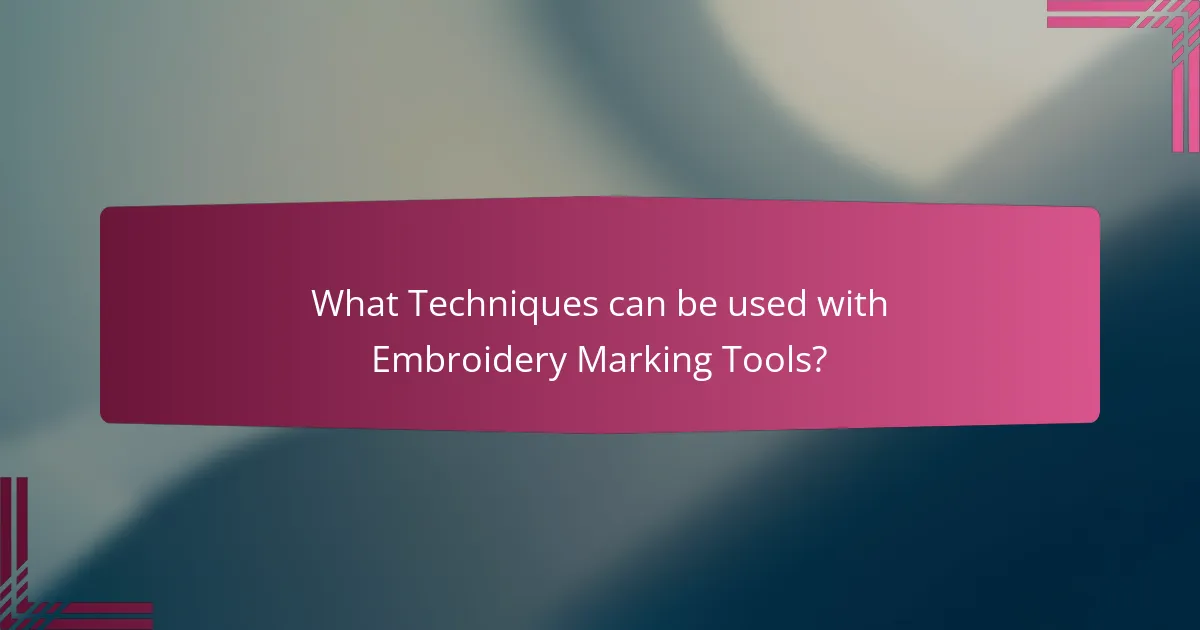
What Techniques can be used with Embroidery Marking Tools?
Embroidery marking tools can be used with various techniques such as tracing, stenciling, and freehand drawing. Tracing involves using a lightbox or window to outline designs onto fabric. Stenciling allows for the application of consistent shapes and patterns using pre-made templates. Freehand drawing enables artists to create unique designs directly on fabric. Each technique requires specific tools like fabric pens, chalk, or water-soluble markers to ensure clear visibility. These tools are designed to provide precision and ease of use, enhancing the overall embroidery process.
What are the best techniques for using Embroidery Marking Tools effectively?
The best techniques for using embroidery marking tools effectively include selecting the right tool for the fabric type. Use water-soluble pens on delicate fabrics to avoid permanent marks. Tailor chalk works well on heavier materials for clear visibility. Always test the marking tool on a scrap piece of fabric first. This ensures that the marks can be removed easily. Use light pressure when marking to prevent fabric distortion. Mark in well-lit areas for precision and accuracy. Following these techniques improves the overall quality of embroidery projects.
How can you achieve the best results with different marking techniques?
To achieve the best results with different marking techniques, select the appropriate tool for the fabric type. Use water-soluble markers for delicate fabrics to avoid permanent marks. Employ chalk pencils for fabrics that can withstand slight abrasion. Ensure proper lighting and a steady hand for precise application. Test the marking technique on a scrap piece of fabric first. Follow manufacturer instructions for specific marking tools to avoid damage. Clean the fabric before marking to ensure adherence. These methods enhance accuracy and prevent mistakes during embroidery.
What common mistakes should be avoided when using these tools?
Common mistakes to avoid when using embroidery marking tools include not testing the tool on a fabric scrap first. This step ensures that the marking will not damage the final project. Another mistake is using the wrong type of marking tool for the fabric. For instance, water-soluble markers are unsuitable for fabrics that cannot be washed. Additionally, failing to consider the visibility of the markings can lead to errors in design placement. Overloading the tool with pressure can cause uneven lines or marks. Ignoring the tool’s instructions can result in misuse and ineffective marking. Lastly, not allowing sufficient drying time for certain markers may lead to smudging during the embroidery process.
How do various techniques impact the final embroidery outcome?
Various techniques significantly impact the final embroidery outcome. Techniques such as digitizing, stitching methods, and fabric choice directly influence the design’s clarity and quality. For instance, precise digitizing ensures accurate stitch placement, resulting in cleaner lines and better detail. Different stitching methods, like satin or fill stitches, affect texture and appearance. The choice of fabric can alter how stitches lay, impacting overall durability and aesthetic. Studies show that using appropriate techniques leads to a 30% increase in design fidelity. Therefore, understanding and applying the right techniques is crucial for achieving high-quality embroidery results.
What are the differences in outcomes based on techniques used?
Different embroidery techniques yield varying outcomes in terms of precision, texture, and durability. For instance, machine embroidery typically results in cleaner lines and faster production compared to hand embroidery. Hand embroidery allows for more intricate designs and a unique, personalized touch.
Additionally, techniques like appliqué create a layered effect, enhancing texture, while free-motion embroidery offers more freedom in design but requires skill for consistent results.
Research indicates that machine embroidery can withstand more washes than hand-stitched pieces, making it preferable for items needing durability. Each technique impacts the final product’s aesthetic and functional qualities, influencing the choice based on the intended use.
How can technique choice affect the durability of embroidery?
Technique choice significantly affects the durability of embroidery. Different techniques determine the tightness and stability of the stitches. For instance, dense stitch patterns provide more durability than loose ones. The type of thread used also influences durability; stronger threads resist wear better. Additionally, techniques like satin stitch can fray more easily than fill stitch. Techniques that involve multiple layers enhance durability through added strength. Research indicates that machine embroidery often outlasts hand embroidery due to precision and consistency. Therefore, selecting the appropriate technique is crucial for long-lasting embroidery outcomes.
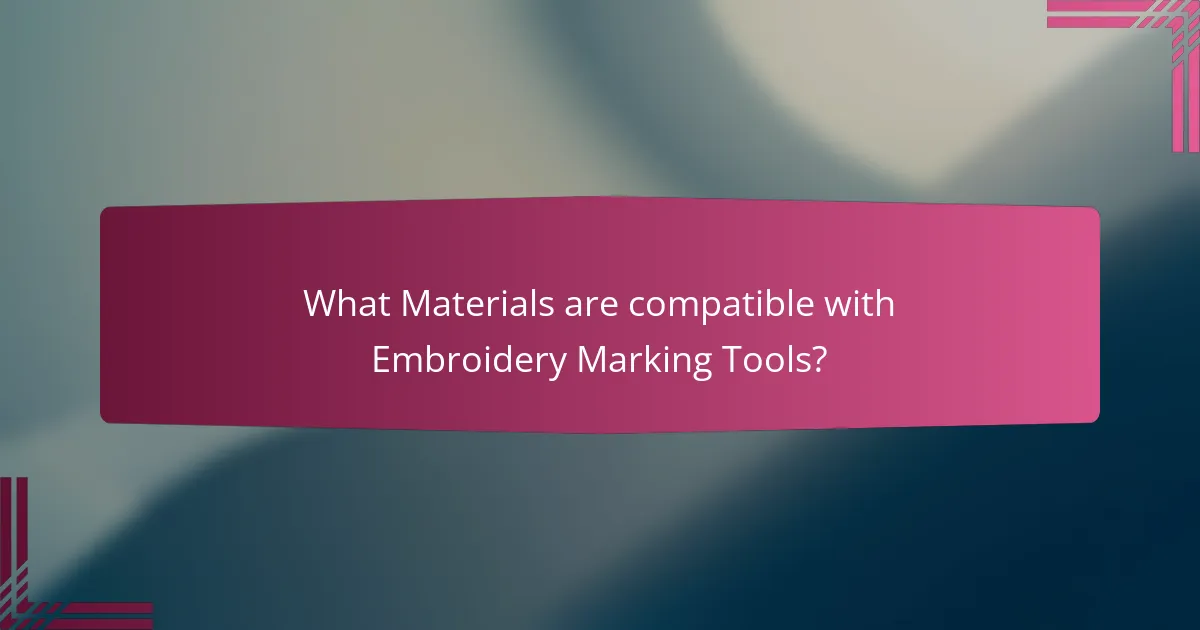
What Materials are compatible with Embroidery Marking Tools?
Embroidery marking tools are compatible with various materials. Commonly used materials include fabric types like cotton, polyester, and linen. These materials hold markings well and are suitable for embroidery. Additionally, some marking tools work on synthetic blends and canvas. Water-soluble and air-soluble markers are ideal for temporary markings. Chalk and pencil can also be used on fabric surfaces. Each material’s compatibility may depend on the specific marking tool used. Proper testing is recommended to ensure desired results.
What types of materials can be marked using Embroidery Marking Tools?
Embroidery marking tools can mark a variety of materials. Common materials include fabric, such as cotton, polyester, and silk. These tools can also be used on denim and canvas. Additionally, embroidery marking tools work well on leather. Some tools are effective on paper for design purposes. Marking tools are designed to provide clear and precise lines on these surfaces. The versatility of these tools allows for diverse applications in embroidery projects.
How does the choice of material affect the marking process?
The choice of material significantly affects the marking process in embroidery. Different materials can influence the visibility and adherence of the marking. For instance, fabric types like cotton absorb ink differently than synthetic materials. This can impact how well the markings show up on the fabric. Additionally, some materials may require specific types of markers or pens to achieve optimal results. For example, water-soluble markers work best on fabrics that will be washed afterward. Conversely, permanent markers may be needed for durable fabrics. The texture of the material also plays a role; smoother surfaces allow for cleaner lines compared to textured ones. Therefore, selecting the appropriate material ensures effective marking and precision in embroidery projects.
What materials work best with specific types of marking tools?
Fabric works best with specific types of marking tools. Water-soluble markers are ideal for cotton and polyester fabrics. They easily wash out after use, making them suitable for temporary markings. Air-soluble markers are effective on various fabrics but may not be as precise. Tailor’s chalk is best for woven fabrics, providing clear lines without damaging the material. Pencils work well on paper patterns and lightweight fabrics, offering precision for detailed designs. Permanent markers are suitable for darker fabrics but require careful application to avoid bleeding. Each marking tool performs optimally when matched with the right fabric type.
What are the best practices for using Embroidery Marking Tools on different materials?
Use embroidery marking tools according to the specific material type for optimal results. For fabric, choose water-soluble markers to avoid permanent stains. Test the marker on a scrap piece to ensure it does not bleed or damage the fabric. On stable materials like canvas, use chalk-based tools for clear visibility. For delicate fabrics, opt for fine-tipped pens that provide precision without causing fraying. Always follow the manufacturer’s instructions for best application techniques. Proper storage of marking tools extends their lifespan and maintains performance. Regularly clean tools to prevent clogging and ensure consistent ink flow.
How can you ensure accuracy and longevity when marking on various fabrics?
Use fabric-specific marking tools for accuracy and longevity. Water-soluble pens work well on most fabrics. They provide clear lines that disappear with water. For permanent marking, use fabric markers that are fade-resistant. Test markers on a scrap piece of fabric to ensure compatibility. Always follow the manufacturer’s instructions for best results. Heat-setting fabric markers can enhance longevity. This process involves applying heat to set the ink. Proper washing and care also extend the life of markings. Avoid harsh detergents and high temperatures during laundry.
What maintenance tips can help prolong the life of marking tools?
Regular cleaning of marking tools prevents ink buildup. Use a soft cloth or brush to remove debris. Store marking tools in a dry place to avoid moisture damage. Ensure caps are tightly secured to prevent drying out. Replace worn-out tips promptly to maintain precision. Avoid exposing tools to extreme temperatures, which can affect their performance. Regularly check for signs of wear and replace as necessary. Following these tips can significantly extend the lifespan of marking tools.
Embroidery marking tools are essential instruments used to create temporary markings on fabric, facilitating accurate design placement before stitching. This article explores various types of marking tools, including fabric pens, chalk pencils, and water-soluble markers, detailing their specific purposes and compatibility with different materials. It also discusses techniques for effective use, best practices for ensuring accuracy and longevity, and the impact of material choice on the marking process. Understanding these elements is crucial for achieving professional-quality embroidery results.
